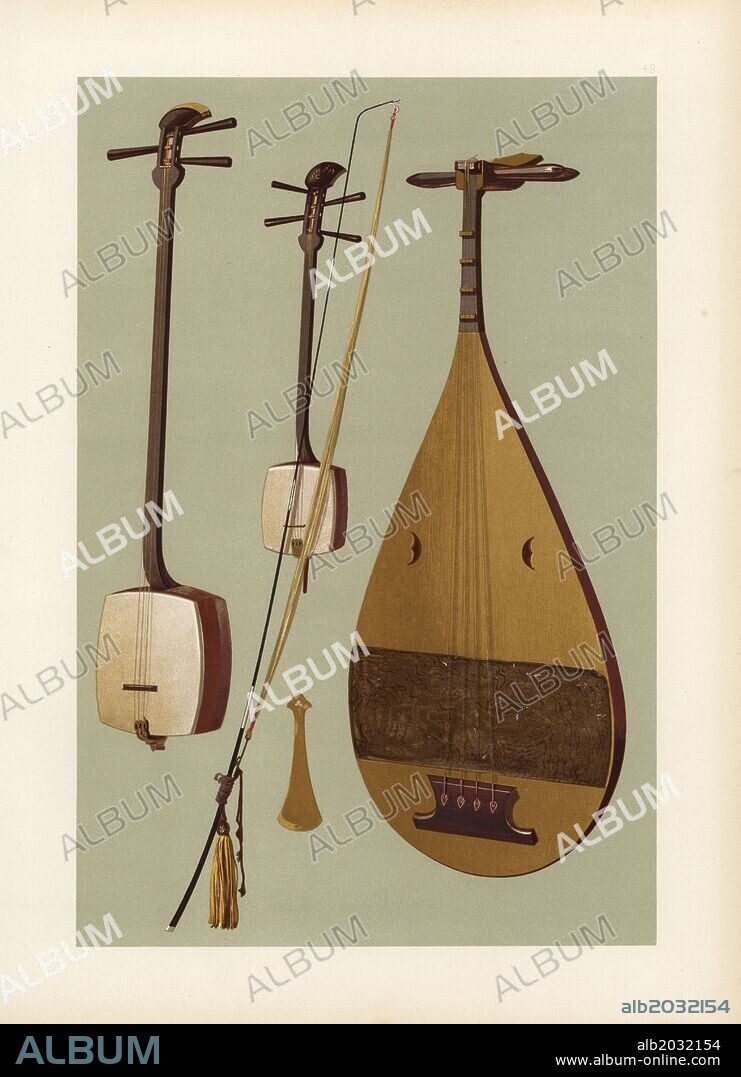alb2032154
Japanese stringed instruments: Siamisen (shamisen), kokiu (fiddle) with long bow and biwa (lute). The Siamesin is the commonest Japanese stringed instrument and is played by the singing girls, geisha. The Kokiu is a kind of fiddle, in its construction very like the Siamesin, only that it is played with a bow (kiu) instead of a plectrum or striker (batsi). The Biwa is a four-string lute-like instrument in the shape of a divided pear, becoming narrower upwards. It is played with a bill-formed batsi, 6 1/2 inches long, made of horn, wood, tortoiseshell, or ivory. Chromolithograph from an illustration by William Gibb from A.J. Hipkins' "Musical Instruments, Historic, Rare and Unique," Adam and Charles Black, Edinburgh, 1888. Alfred James Hipkins (1826-1903) was an English musicologist who specialized in the history of the pianoforte and other instruments. William Gibb was a master illustrator and chromolithographer and illustrated "The Royal House of Stuart" (1890), "Naval and Military Trophies" (1896), and others.

|
Ajouter à une autre Lightbox |
|
Ajouter à une autre Lightbox |



Avez-vous déjà un compte? S'identifier
Vous n'avez pas de compte ? S'inscrire
Acheter cette image

Légende:
Voir la traduction automatique
Japanese stringed instruments: Siamisen (shamisen), kokiu (fiddle) with long bow and biwa (lute). The Siamesin is the commonest Japanese stringed instrument and is played by the singing girls, geisha. The Kokiu is a kind of fiddle, in its construction very like the Siamesin, only that it is played with a bow (kiu) instead of a plectrum or striker (batsi). The Biwa is a four-string lute-like instrument in the shape of a divided pear, becoming narrower upwards. It is played with a bill-formed batsi, 6 1/2 inches long, made of horn, wood, tortoiseshell, or ivory. Chromolithograph from an illustration by William Gibb from A.J. Hipkins' "Musical Instruments, Historic, Rare and Unique," Adam and Charles Black, Edinburgh, 1888. Alfred James Hipkins (1826-1903) was an English musicologist who specialized in the history of the pianoforte and other instruments. William Gibb was a master illustrator and chromolithographer and illustrated "The Royal House of Stuart" (1890), "Naval and Military Trophies" (1896), and others.
Crédit:
Album / Florilegius
Autorisations:
Modèle: Non - Propriété: Non
Questions sur les droits?
Questions sur les droits?
Taille de l'image:
4272 x 5900 px | 72.1 MB
Taille d'impression:
36.2 x 50.0 cm | 14.2 x 19.7 in (300 dpi)
Mots clés:
ART, LITHOGRAPHIES • ARTISTE • ARTISTEL • ARTSTE • BANJO • CHANSONS • CHANT • COMEDIE MUSICALE • COULEUR • GEISHA • HISOIRE • HISTOIRE • HISTORIQUE • ILLUSTRATEUR • ILLUSTRATION • INSTR. MUS. LUTH • INSTR. MUS. VIOLON • INSTRUMENT • INSTRUMENTS • ISNTRUMENT • LITHOGRAPHE • LITHOGRAPHIE • LUTH • LUTH, INSTR. MUS. • MUSICAL • MUSICALE • MUSIQUE • MUSIQUE: CHANSONS • MUSISQUE • RARE • SHAMISEN • TECHNIQUE: LITHOGRAPHIES • VIELLE • VIOLON • VIOLON, INSTR. MUS.
 Pinterest
Pinterest Twitter
Twitter Facebook
Facebook Copier le lien
Copier le lien Email
Email
